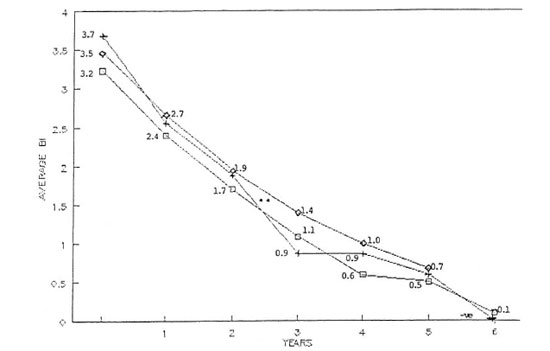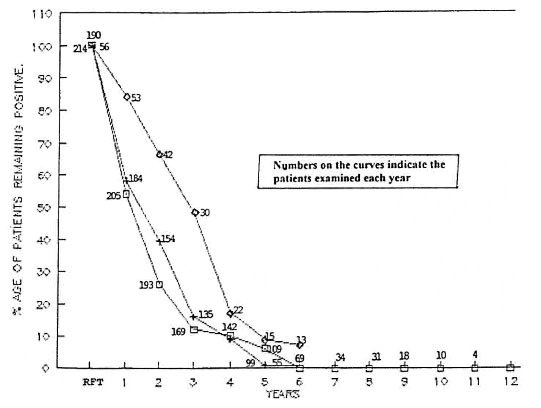- Volume 65 , Number 2
- Page: 264–6
Rate of decline in bacterial index in leprosy; observations after three different chemotherapeutic interventions
To the Editor:
Continuation of chemotherapy with bactericidal drugs in leprosy patients is generally practiced with a view to achieving a fall in the bacterial index (BI) even beyond the optimum period needed for "bacterial kill." Drawing samples From routine field programs with reliable skin-smear facilities (2), the decline in the percentage of multibacillary (MB) patients remaining positive after fixed-duration multidrug therapy (FDT) for 24 months and 12 months, respectively, has been documented (1).
We now report our observations over the years on 460 BL/LL patients who have completed the following courses of FDT (see table below).

Due to change in the concepts on FDT over the years, all patients could not be recruited at the same point of time. We have considered the mean BI of the three groups of patients available every year following pretreatment BI (Fig. 1). It is noticed that the pretreatment BI, which is comparable in the three groups, has by and large declined in a similar manner over the study period.
 Fig. 1. Mean bacterial indexes over 6 years of 460 BL/LL patients completing FDT. □= FDT for 12 months; + = FDT for 24 months; ◊ = rifampin + ofloxacin for 28 days.
Fig. 1. Mean bacterial indexes over 6 years of 460 BL/LL patients completing FDT. □= FDT for 12 months; + = FDT for 24 months; ◊ = rifampin + ofloxacin for 28 days.
Figure 2 shows the percentage of patients remaining positive at yearly intervals (depending upon the number of patients available for follow up each year). There is apparently a parallel decline of patients remaining positive among the three groups. The inclusion of a much higher proportion (16%) of cases with a BI of >5 in the RO group (as opposed to 3%-7% in the WHO/MDT groups) might account for the slight shift of the Group III curve to the right. A total of 355 (77%) out of 460 patients [186 (87%) in Group I, 139 (73%) in Group II and 30 (54%) in Group III] have been rendered skin-smear negative. No relapse has been encountered in any of the groups (the follow-up period for Group I being 11 years).

Fig. 2. Percentage of patients remaining positive at yearly intervals (depending upon the number of patientsavailable for follow-up each year). □ = FDT for 12 months; + = FDT for 24 months; ◊ = rifampin + ofloxacin for 28 days.
Six years of experience with extremely brief treatment of 4 weeks has indicated results parallel to 12-month and 24-month interventions. We can, therefore, foresee the prospects of considerable savings in manpower and costs in the antibacterial approach and the possibility of diversion of such reserves to other equally important facets of leprosy management. Long-term results of WHO multicenter chemotherapy trials on larger samples of patients will be eagerly awaited to see if such prospects are indeed realistic enough to justify a change in global strategies of leprosy eradication.
- Dr. R. Ganapati
Director
- Dr. V. V. Pai
Deputy Director
Bombay Leprosy Project Vidnyan Bhavan
I VN Purav Marg, Sion Chunabhatti
Mumbai 400 022, India
- Dr. H. J. Shroff
Professor and Head
Department of Skin, VD and Leprosy
Grand Medical College
Sir J J Group of Hospitals
Mumbai 400 008, India
- Kailas Gandewar
Bio-Statistician
LTM Medical College, Sion Hospital
Mumbai 400 022, India
REFERENCES
1. Ganapati, R. Leprosy- A Glimpse at the Changing Scenario. Bombay: Acworth Leprosy Hospital Society for Research, Rehabilitation and Education in Leprosy and Bombay Leprosy Project, 1996, p.30.
2. Ganapati, R., Shroff, H. J., Gandewar, K. L., Prasad Rao, B. R., Pai, R. R., Kute, A. S., Fernandes, X. J., Revankar, C. R. and Pawar, P. L. Five Year Follow-up on Multibacillary Leprosy Patients after Fixed Duration Chemotherapy. Proceedings of the VI Symposium on Leprosy Research, Genoa, Italy, 1996, pp. 223-229.